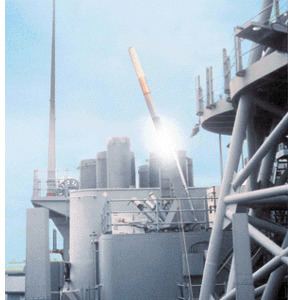 | ||
Nulka is an Australian designed and developed active missile decoy built by an American/Australian collaboration. Used aboard warships of the United States Navy (USN), Royal Australian Navy (RAN), United States Coast Guard (USCG), and Royal Canadian Navy, Nulka is a rocket propelled, disposable, offboard, active decoy designed to ″seduce″ anti-ship missiles away from their targets. It has a unique design in that it hovers in mid air while seducing the incoming anti-ship missile. The hovering rocket concept was initiated in Australia by the Defence Science and Technology Organisation (DSTO), and the system was designed, developed and then manufactured by AWA Defence Industries (AWADI) (now BAE Systems Australia). The word "Nulka" is of Australian Aboriginal origin and means "be quick".
The Nulka consists of the missile itself enclosed in a hermetically sealed canister. This canister is then contained in a Launcher module (as fitted to RAN and USCG vessels), or a Mark 36 launcher (as fitted to USN vessels).
As of October 2010 Nulka had been fitted to more than 150 Australian, Canadian and United States warships and over 1,000 decoys had been produced. At this time it was expected that the system would be fitted to US Navy's Nimitz-class aircraft carriers as well as Australia's future destroyers. This made the system Australia's most successful defence export.
In 2012 Lockheed Martin announced that it had successfully tested its new ExLS (Extensible Launching System) for Nulka. The tests were conducted at the Woomera Test Range, Australia.
On 9 October 2016, the guided-missile destroyer USS Mason deployed its Nulka decoy when it and two other US warships, USS Ponce and USS Nitze, came under fire by two missiles fired by Houthi rebels off the Yemeni coast around 7 PM local time.
